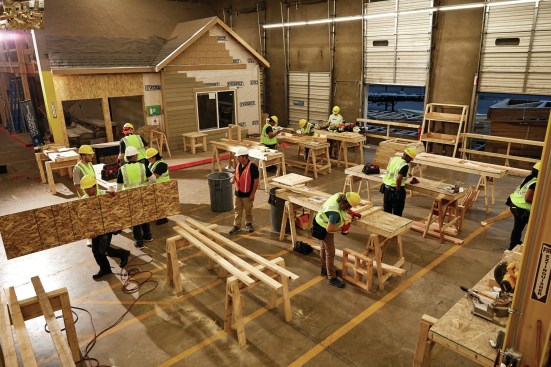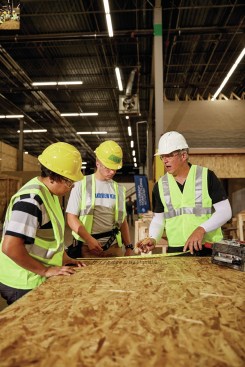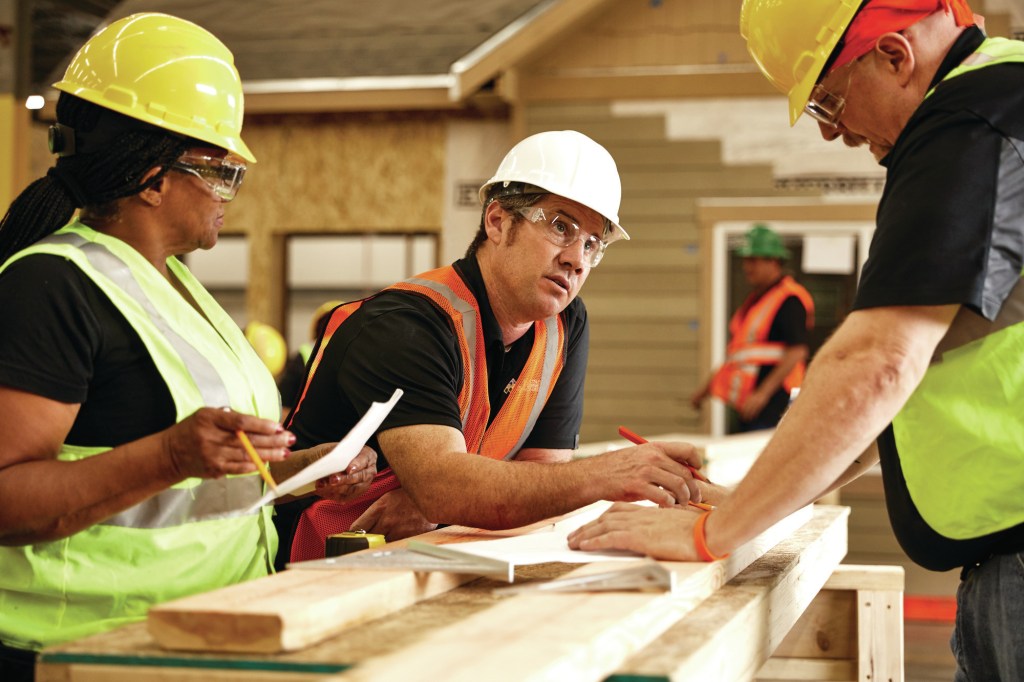Five years ago, Jennifer Johnson, founder and CEO of the Construction Trade School in Dallas, started to talk to home building and remodeling organizations about a looming labor shortage in the residential construction trades. She called it a crisis, but industry leaders were focused elsewhere. Their No. 1 priority at the time was recovering from the recession, and many felt labor was a subcontractor problem, not theirs.
“It’s kind of like those shows you watch where there’s a tidal wave, and the scientists know it’s coming, and nobody gets a boat ready,” Johnson says.
As the impending shortage began to affect builders’ bottom lines, however, more and more took notice. Over the past few years in the Dallas/Fort Worth area, the lack of qualified labor has increased housing prices, delayed building times, and created uncertainty for builders and manufacturers.
Today, the need for construction labor is near an all-time high, says Brian Miller, executive vice president of the Home Builders Association of Northern Kentucky, noting that workforce shortages in skilled trades across the nation are builders’ No. 1 issue. “It’s slowing down contracts, it’s slowing down build times,” he says. “In many cases, contracts to build are being lost as a result of the lack of skilled trades.”
Recent devastating hurricanes in Texas and Florida have compounded the need for qualified workers in those areas, which have struggled with severe labor shortages for years. Houston is the No. 2 new-home market in the country based on closings, according to BUILDER’s 2017 Local Leaders ranking, and Orlando and Miami were among last year’s fastest-growing cities in the country. Among the builders active in these areas are D.R. Horton, CalAtlantic, Lennar, K. Hovnanian, Taylor Morrison, KB Home, PulteGroup, Beazer Homes, and Meritage Homes, along with numerous private and custom builders.
Meanwhile, in Colorado, where unemployment is the country’s lowest at 2.3% and Colorado State University construction management experts expect a 38% increase in vacancies in the construction trades by 2025, a recent Denver Post front-page article warned of a “massive shortage of construction workers.” The training and business development manager for Denver’s Office of Economic Development told the Post that if trained workers don’t show up soon, “it will impede the rate at which the economy can grow.”
Noting that construction labor shortages are becoming severe in many parts of the country, trade groups including the NAHB and the Associated General Contractors of America (AGC) are urging Congress and the Trump administration to shore up the Perkins Act, which provides Americans with career and technical education. Read more about that here.
Career Path
These days, with the labor shortage in full effect, Johnson says home building executives are not only paying attention but also mobilizing to address the problem. More than 50 local contractors and suppliers support Johnson’s trade school by volunteering to speak to classes, host students at jobsites, and network at career fairs. The school enjoys backing from builders and manufacturers including Taylor Morrison, Alair Homes, Benjamin Moore, and Schluter Systems, and local companies are clamoring to hire the school’s graduates, who are carefully placed based on personality tests.
In Dallas and across the country, the home building industry is looking for creative ways to increase the number of workers entering the construction field, but it’s proving to be a big job. Trade schools and construction management programs say they have trouble finding students, even when scholarships are offered.

Photography by Jeff Nelson
Students learn the details of constructing a home from instructors at the Colorado Home Building Academy.
Many factors are keeping young people away. Recent high school grads getting ready to choose a career path no longer find home building to be a respected career that can reward them with a stable life and good income. In fact, in a recent NAHB survey, very few young people who know what they want to be chose home building as a career path.
In addition, the housing crash and recession pushed out epic numbers of residential construction workers who never returned. Those workers, burned and bitter, have encouraged their children to stay away from the trades. Millennials, who came of age as the home building industry crashed, see residential construction trades as unstable, risky, and low-paying.
“In Europe, people in the construction trades are revered as fine artists, but here, there’s a stigma to working outside and people look down on the construction trades,” Miller says. “We’ve done ourselves a disservice as an industry by having companies that don’t represent themselves well. When people see beat-up vans and workers burned by the sun at jobsites, they get the impression that we don’t operate in a professional manner.”
Layer that negative viewpoint on top of an overall decline in the total labor force—most prevalent among young men—that the Federal Reserve says is “nearly unprecedented in the postwar experience,” and the problem becomes even more dire. Recent studies have found that an alarming number of young men are working fewer hours than previous generations and staying home to play video games instead. The number of men from age 21 to 30 who are not working or enrolled in full-time education has nearly doubled, from 8% in 2000 to 15% in 2016, and researchers from Princeton University and the University of Chicago argue that “innovations in gaming/recreational computing” explain as much as 79% of that increase.
At the same time, most construction managers, electricians, and carpenters are older than the U.S. median age. As they retire, they’re leaving gaps in the workforce and young workers without mentors.
“When I talk to building groups, I look around the room and—with the exception of those of us who use Miss Clairol—I see a lot of gray hair,” says Cindy Hall, executive director of Future Builders of America, a charitable arm of the Florida Homebuilders Association that provides scholarships and training for students entering the construction industry. “All of a sudden, everybody’s going, ‘Oh my goodness, we’re in our 50s and 60s, and nobody’s trained to take over, and we’re getting tired.’ Everybody’s in crisis mode because kids these days don’t even know how to use a wrench. It’s going to hit people in their pocketbooks, and it’s going to hit them hard.”
Building Exposure
If you remember high school shop class—those labs where students, almost all of them male, learned to work with power tools and draft blueprints with an instructor who was also the football coach—you’re probably over 40. In many U.S. school districts, shop class died in the 1980s and 1990s, a victim of budget cuts and underfunding of career and technical education programs, risk and liability issues, and lack of interest as skills like PowerPoint and Excel became more valuable and guidance counselors were told to push all students—even those who aren’t cut out for it—toward four-year colleges and universities.
Today, Miller says, kids who don’t do well in traditional academic subjects have no adequate pathways to discover alternatives. “They’re faced with, ‘Sit down, shut up, and read a book or you’re screwed,’” he says. “What is a young person to do but think they’re a big f-up because they can’t? Absent any other options, where are they going to go?”

Photography by Jeff Nelson
Spurred by Colorado's severe labor shortage, Oakwood Homes’ CEO Pat Hamill helped to found the CHBA to train students for a range of home building jobs.
“Across America today, everything is geared toward kids going to college,” agrees Pat Hamill, CEO of Denver-based Oakwood Homes. “Technical programs have just gone by the wayside for the most part, and we’ve not done a good job of exposing young people to the fact that you can have a fulfilling, high-paying career in the housing industry.”
This year, through Oakwood’s philanthropic arm, Hamill created the Colorado Home Building Academy (CHBA), a nonprofit educational resource that provides hands-on training and job placement for workers, job seekers, and students through its own classes and partnerships with the University of Denver and Community College of Aurora. Michael Smith, the academy’s director, says the home building industry has utterly failed to attract millennials, who don’t appear to be interested in building things “unless they’re building them in Minecraft.”
A recent NAHB survey asking 18- to 25-year-olds about career choices proves Hamill’s and Smith’s point. Rose Quint, NAHB assistant vice president for survey research, undertook the survey after builders repeatedly reported that lack and cost of labor were their biggest problems. In a recent survey, eight out of 10 builders identified the issue as their most significant challenge in 2017. “Builders are paying workers more money because that’s the normal capitalist solution,” Quint says, “and yet they still can’t find people.”
New Recruits
Click here for a look at five young people who are setting their sights on a job in home building.
Quint calls the results of her young adult survey “sobering but not necessarily surprising.” Of the 75% of young people who knew what career they wanted to be in, only 3% across every segment—race, ethnicity, gender, region—were interested in construction, which tied with government and the performing arts as the second-least desirable career (above the military with 2%). Worse, 63% of the undecideds said there was no or little chance they could be enticed into the trades no matter how much money they were offered.
When Quint asked why, the young people said they wanted less physically demanding work, and that construction work is difficult.
That stereotype of home builders “working all day in the hot sun” is pervasive, damaging—and ironic, according to Manny Gonzalez, managing principal of KTGY Architecture + Planning’s Los Angeles office. “It’s an interesting chicken and egg because millennials can’t find affordable housing in areas where they want to work,” he says, “but they don’t want to get into the business of building those houses—even though there’s plenty of opportunity.”
The puzzle for the home building industry is finding a way to make residential construction—one of the world’s least digitized sectors—exciting for generations that have grown up with tablets and Tinder. “Maybe,” Gonzalez suggests, “we should make a video game about it.”
Call to Action
When the NAHB analyzed Quint’s survey data for a report, “Young Adults & the Construction Trades,” it found what it calls “helpful news.” Many of the 18- to 25-year-olds who in theory wouldn’t work in the trades said they would reconsider if they could make $75,000 or more per year. While the report makes it clear that the average salary in the home building trades is well below that, the authors note that $75,000-plus salaries are available to the top 10% to 25% of workers. “It may be worthwhile to make this more widely known,” they conclude.

Construction jobs actually pay better than most other industries, according to the AGC. Depending on skill level, trade specialty, and geographic region (the highest-paid workers are in New York, Illinois, Massachusetts, Hawaii, and New Jersey), entry-level residential construction workers make anywhere from $12 to $20 per hour, and that can easily double or triple within three years. Nationwide, average hourly earnings in the construction industry are $28.55—a 2.2% increase over 2016 and nearly 9% more per hour than the average nonfarm private sector job in the United States. The top one-quarter of construction workers in positions such as top-line supervisor, plumber, pipefitter, steamfitter, and electrician earn at least $75,000 annually and get benefits including paid vacation and sick leave, health insurance, and 401(k) plans, according to the Bureau of Labor Statistics.
A worker who is promoted to vice president of construction for a larger home builder could earn well more than $100,000.
Jill Herman, who directs the California Homebuilding Foundation’s Building Industry Technology Academy (BITA), a four-year high school trades curriculum designed by the industry and educators to get kids in 21 California high schools excited about construction, says California educators have turned a corner and are promoting careers alongside college again. Now, she says, the home building industry needs to be proactive about attracting young people with outreach, internship programs, employment opportunities, and competitive wages.
“Industry support is the driving factor for the BITA program. The whole point of BITA is for the industry to get involved through participation with the schools and students,” Herman says. “A teacher can talk to students all day long about construction as a great opportunity, but until students meet or learn from professionals in the industry who are passionate about their work or partake in real-life experiences such as visiting a jobsite or learn a new skill hands-on, it doesn’t click.”
That’s the premise behind the HBA-sponsored Enzweiler Building Institute, the nation’s longest-running post-secondary apprenticeship training program that just received a $2.69 million grant from the Kentucky Education & Workforce Development Cabinet to address the workforce gap in construction trades. Courses are developed and taught by tradespeople, Miller says, and the evening program for adults benefits from being outside the traditional education system.
“We can be less rigid,” says Miller of the Home Builders Association of Northern Kentucky. “We don’t have to report curriculum to a board of education.”
In Madison, Wis., contractors and trade associations desperate for workers are throwing so much money into scholarships for students enrolled in the construction and remodeling program at Madison Area Technical College (MATC) that administrators worry it will go unused. “We find ourselves almost begging students to apply for scholarships because we hate to see money left on the table,” says MATC instructor Allie Berenyi.
Even so, Berenyi admits, recruiting for the yearlong state-accredited program, which costs about $5,000 in tuition, fees, and tools, can be a challenge. When she and her team visit schools and career events, they’re happy if they score even one potential student. Berenyi is also concerned that the Trump administration’s tough immigration policies are discouraging applicants. “If you’re at all unsure about your documentation or you’re sure it’s not adequate, you’re not going to apply to a big public institution,” she says. “And that’s a real shame because immigrants have historically helped fill labor gaps in construction.”
Like many other construction schools, Madison Tech is trying to fill its own gaps by reaching out to underemployed and hidden populations such as military veterans and people who have been incarcerated. The CHBA is also targeting marginalized populations, and Hamill tells a story about Dominic, a homeless student who moved from one viaduct to another in Denver so he wouldn’t be late for his classes. The academy team worked with the Denver Workforce Center to get Dominic support services, clothes, and housing, and he found a job with an HVAC company after he completed the program.
Employers also are looking to female workers to help alleviate the labor crisis. Women comprise 50.1% of the population but make up just 12% of the nation’s total construction workforce, according to the Bureau of Labor Statistics. That number hasn’t budged for decades, but the current labor crisis could finally start pushing it toward equilibrium as employers and industry groups scramble to make inroads with a population they’ve ignored and even discouraged in the past.
“We try every day to recruit women,” says Smith of the CHBA. He’s proud to report that women make up 40% of the academy’s incoming class of 12 people, and he believes more women will enter the industry as they realize it’s full of jobs where they don’t have to lift 150 pounds. The rise of factory-built and pre-fabricated modular homes, which are less physically challenging to build and can be constructed indoors, is making home construction more attractive to women, and companies are finding that female employees exceed expectations. Hamill has nothing but praise for the seven women who build and assemble wall panel systems at Oakwood’s factory in Utah. “They show up on time; they’re disciplined,” he says. “It’s very new for us to have them on the factory floor. We’re excited.”
Industry Support
Suppliers and manufacturers are worried about filling jobs, too, and some of them are taking responsibility to entice young workers to consider construction-related careers.
During the Super Bowl, 84 Lumber’s commercials directly appealed to potential job candidates to consider joining the company. The firm’s digital strategy includes social media, videos, and display ads targeting people of all ages who don’t follow the conventional career path and problem solvers with the aptitude and attitude for success, says 84 Lumber president and owner Maggie Hardy Magerko.
“People like to talk about the housing market recovery, but what they don’t talk about is the fact that the recovery isn’t happening as quickly or as largely as it could be,” says Hardy Magerko. “It’s not a lack of demand—it’s a lack of inventory. We need to build more homes at all price points, because everyone deserves the American dream. But we can’t do it if we don’t have the right people to do the work.”
Since the Super Bowl, 84 Lumber has hired more than 750 new employees and has seen a 191% increase in the number of individuals joining the 84 Lumber talent network.

Photography by Jeff Nelson
Students at the CHBA in Denver gain hands on experience for a range of home building jobs. The academy is open to adults and high school students in the Denver area.
Late this summer, OSB manufacturer Norbord launched its “Thank a Framer” social media campaign, citing the fact that more than 70% of U.S. builders face a shortage of framers. The firm donated $100,000— and an additional $1 million in light of recent hurricanes—to the Home Builders Institute (HBI), a Washington, D.C.–based organization that provides training for prospective construction professionals, veterans, and underserved youth across the country.
Other industry partners work on a local level, providing training and equipment for high schools, trade schools, and community colleges. For instance, Bosch Thermotechnology recently donated a variety of HVAC units to the Atlantic Technical College and Technical High School in Coconut Creek, Fla. Executives met with students and teachers and answered questions about what it’s like to work in the HVAC industry.
“It was very obvious that these students are eager to learn and gain hands-on experience,” says Adrian Smith, technical service associate at Bosch.
KTGY’s Los Angeles office is a prime example of the way industry players are getting involved to alleviate labor woes. Employees there have been mentoring high school students interested in design–build for six years. Volunteers work through the Architecture Construction Engineering (ACE) Mentor Program Los Angeles with students at Bell High School in Bell, Calif., which has a 98% Latino student population. Last year, KTGY employees and the students toured the Wilshire Grand Tower that was under construction in downtown LA and took in a Frank Gehry exhibit at the Los Angeles County Museum of Art. It was many of the students’ first visit to an art museum.
“These kinds of activities serve to inspire and spark the imagination,” says KTGY project manager Anabel Martinez, who has been involved in the ACE program for nearly 14 years. “Introducing them to career possibilities in the construction and design industry sparks their excitement, and this is contagious.”



